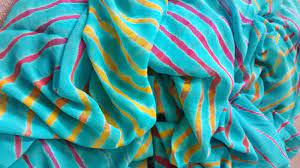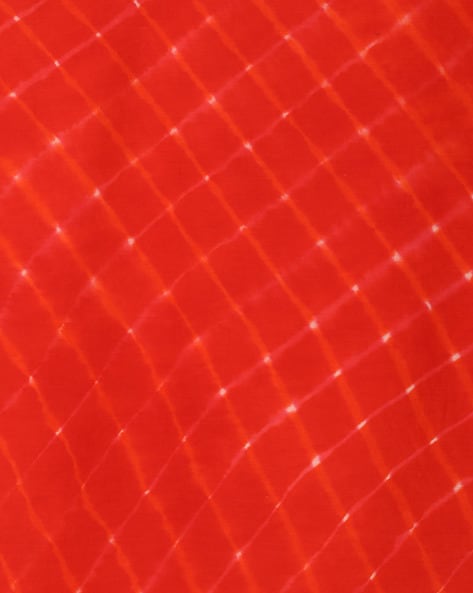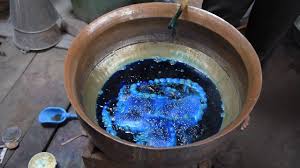Leheriya Printing
Leheriya Prints is a traditional style of tye-dye practiced in the state of Rajasthan, India that results in brightly colored cloth with distinctive patterns. Leheriya is a Rajasthani dialect that means “Wave”. The technique is named “Leheria” because the dyeing technique is often used to produce wave patterns. Leheriya was conceived in the nineteenth century and early twentieth century and has since been patronized by traders and merchants. Within the domain of Tye and Dye, Leheriya is the most recognized design.
The Leheriya Printing Technique
Leheriya dyeing is done on thin cotton or silk cloth. The cloth is usually the size of a dupatta, turban, or sari, The fabric is rolled diagonally from one corner to the opposite selvage and then tied at the required intervals and dyed. Wave patterns result from fan-like folds made before dyeing. Traditional leheriya employs natural dyes and multiple washes and uses indigo or alizarin during the final stage of preparation.

Mothara Printing

Mothara is produced by using additional dyeing in the leheriya technique. In the making of Mothara the original resists are removed and the fabric is re-rolled and tied diagonally. This results in a checkered pattern with small undyed areas occurring at regular intervals. The undyed areas are about the size of a Lentil hence the name mothara. Moth means lentil in Hindi.
A Brief History of Leheriya Prints
India’s expertise in natural and vegetable dyes dates back to the Indus valley civilization as proved by the findings of dyes cotton fabric pieces there. In fact, India enjoyed a monopoly in the production of dyed, painted, and printed textiles for a long time. Until recently, all hand-printed techniques included the usage of natural dyes only. Block Printing and Tie-Dye were the first hand-printing techniques to emerge in India. The various print motifs from Gujrat and Deccan have gained popularity abroad especially in Europe in the 16th and 17th centuries.
The Making of Leheriya Prints
The dyer skillfully paints magic onto a cotton or silk cloth. The cloth manufacturer uses a special method known as resist dyeing. The dyer uses a special cloth in the dyeing process that is of lighter color, generally in cotton, silk, chiffon, or georgette. The cloth is tied and folded in such a manner that when it is opened, there is a striped pattern created on the cloth on every alternate stripe. Traditionally, craftsmen would tie and dip it in five different colors to get the desired pattern in multiple hues. The craftsmen used natural colors and finished off with indigo for shades of blue, and Alizarin for the hues of red in the final stages. Depending on the skill and imagination of the craftsmen, every fabric gets a new look, with vivid colors, fresh patterns, and vibrant designs.

Like Block Printing and Wooden Printing Blocks, The Leheriya style has been inspired by regions in and around Gujarat in Rajasthan. The leheriya Motifs and designs portray a sense of joy and colorfulness, retaining the simplicity of the culture of Gujarat.
What Inspires Leheriya Prints
Leheriya style has been influenced and inspired by Gujarat and Rajasthan. The motifs and designs portray a sense of joy and colorfulness while retaining the simplicity of the region’s culture. Leheriya Styles and Patterns has been able to retain its original essence ever since its inception. Slowly and slowly, Leheriya style was introduced in Lehenga Cholis, Salwar Kameez, and Sarees. You can find leheriya style on ethnic and casual clothing, bags and clothing, and scarves and cravats.
Global Recognition of Leheriya Prints
Leheriya styles and its bright colors and the lightness of the fabric make it a great fit on the Global stage. It has become a popular fabric in the export market also and is showcased in fashion shows worldwide.
Leheriya Prints are preferred in regions with a warmer climate as it is usually created on soft and silk fabrics.
Wearing Leheriya Attire
Lehriya has light and vibrant hues that make it apt for spring and summer wear, The colorful leheriya fabric in the form of a dupatta can be used to adorn solid-colored kameez. Leheriya prints can also be teamed up with Indo-western attires to make them more vibrant.
Maintaining Leheriya printed fabrics
A leheriya-adorned fabric can easily be maintained like any other georgette or cotton fabric. One common problem that most buyers face is color bleeding. However, the problem can be solved by soaking the garment overnight in a bucket of water that contains a teaspoon of salt. The process fastens the colors on the cloth.
Interesting Facts about Leheriya Prints
Here are a few of the Interesting facts about Leheriya:
- Leheriya prints have been the exclusive style of the Marwari community.
- The royal class always wore Blue leheriya attire.
- White is the most common base color for leheriya.
- Leheriya is much easier to maintain than a style like a block printed.
- The price of leheriya printed apparel depends on the number of times the cloth has been dyed.
